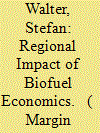|
|
|
Sort Order |
|
|
|
Items / Page
|
|
|
|
|
|
|
| Srl | Item |
| 1 |
ID:
160032


|
|
|
|
|
| Summary/Abstract |
Policy initiatives and regulatory changes made during the last two-and-half decades of economic reforms have led to a considerable increase in the number of mergers and acquisitions (M&As) in the Indian corporate sector. Given the policy-induced flexibilities, while the domestic firms have taken the route of mergers to restructure their business and grow, the foreign firms have preferred to enter into specific markets through acquisitions and raise monopoly power therein. In this context, the present article attempts to examine the impact of M&As on market the structure in major industries of the Indian manufacturing sector during the post-reform period. Using a panel dataset of 34 major industries for the period 2001–2009, the article finds that M&As do not necessarily cause any appreciable adverse impact on market concentration. Instead, the degrees of sellers’ concentration are influenced by the growth of market, capital intensity, firms’ advertising efforts and their financial performance. The findings of the present article, therefore, suggest for a rethink on policies and regulations relating to M&A, international trade and intellectual property, as they play a significant role in enhancing firms’ competitiveness and restricting the emergence of a monopolistic power.
|
|
|
|
|
|
|
|
|
|
|
|
|
|
|
|
| 2 |
ID:
160033


|
|
|
|
|
| Summary/Abstract |
The article is an attempt to assess India’s fiscal and external sector vulnerability in the context of the deterioration in major macroeconomic indicators in recent years. The balance sheet approach (BSA) developed mainly by the International Monetary Fund (IMF) is applied to analyse episodes of major fiscal, financial and external payment crises in developing countries between the late 1990s to early 2000. The present work assesses the vulnerability in India’s fiscal and external sectors by descriptive and comparative analyses of relevant indicators and developing a composite vulnerability index (CVI) consisting of the indicators under study. Fiscal or external sector vulnerability can also be assessed by how easily or smoothly a government or a nation can finance its budgetary deficit or rollover of debt or the external sector funding needs. The method of financing and management of debt-related liabilities become important in this context. This may get reflected in currency composition, maturity pattern and ownership pattern of liabilities. The CVI score and favourable currency composition, maturity pattern and ownership pattern of liabilities largely helped India reduce both fiscal and external sector liabilities significantly in recent years.
|
|
|
|
|
|
|
|
|
|
|
|
|
|
|
|
| 3 |
ID:
160034


|
|
|
|
|
| Summary/Abstract |
This article attempts to document the status of environmental fiscal instruments (EFIs) so as to explore relevant international experiences on ecotaxes in the context of India and to examine India’s specificities in these taxes within a wider perspective of other fiscal measures. Environmental levies across 15 countries were reviewed and the countries categorised are into two groups: Annex II and Non-Annex I. The revenues from levies imposed in the countries were also analysed. The most common form of taxes in Annex II countries in the form of energy taxes, followed by transport taxes. For India, energy and transport taxes could prove to be vital types of ecotaxes for addressing issues of climate change. Pollution taxes are difficult to levy for administrative reasons, but resource taxes are imperative because of severe environmental problems associated with mining and related activities. The revenue generated from environmental taxes and charges for all Annex II countries hovered between 2 and 4 per cent of their respective GDPs, except for Canada and the United States of America, whereas for Non-Annex I nations, this ranged only between 0 and 1 per cent.
|
|
|
|
|
|
|
|
|
|
|
|
|
|
|
|
| 4 |
ID:
160035


|
|
|
|
|
| Summary/Abstract |
The European Commission has developed a series of regulatory measures to introduce alternative energy technologies, including a binding target for a specified share of biofuel in petrol and diesel, in European Union (EU) member states. The instruments to achieve this goal include taxation, subsidies and legal restraints. Biofuel suffers from the problem of being uncompetitive, and the intervention addresses the price gap between conventional fuel and biofuel.
|
|
|
|
|
|
|
|
|
|
|
|
|
|
|
|
| 5 |
ID:
160031


|
|
|
|
|
| Summary/Abstract |
We estimate the determinants of credit and of non-performing assets (NPAs) using a firm and a bank panel with data up to 2015 in order to test bank lending against the aggregate demand channel as an explanation for slow Indian credit growth. The results support demand as the key constraint. Only demand variables affect corporate credit for a broad set of firms. Balance sheet weakness reduced credit only for a narrow subset of indebted firms in a difference-in-difference type analysis. Even so, sales remained the dominant variable. From the bank panel, the asset quality review (AQR) did have a strong negative effect on advances but gross NPAs did not. While high interest rates and low growth raised NPAs, so did past credit. Low demand not only reduced credit, it also increased NPAs. That the capital adequacy ratio (CAR) significantly reduces NPAs points to the productivity of fund infusion. When other determinants are controlled, bank ownership does not affect NPA ratios, again supporting external shocks as causal. The results suggest that apart from structural reform to clean balance sheets, recovery of demand is necessary for revival of credit growth.
|
|
|
|
|
|
|
|
|
|
|
|
|
|
|
|
|
|
|
|
|